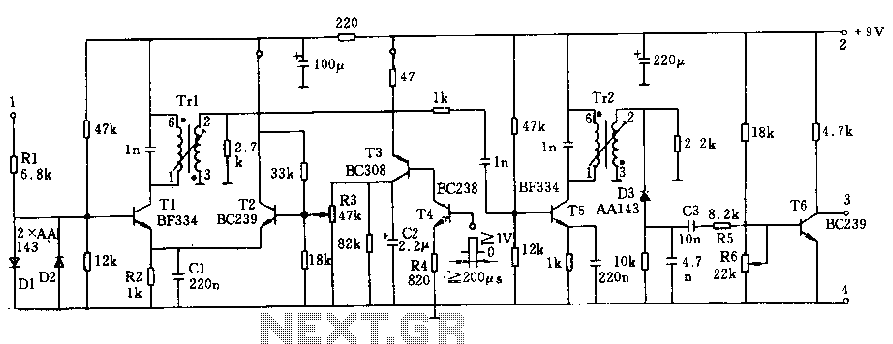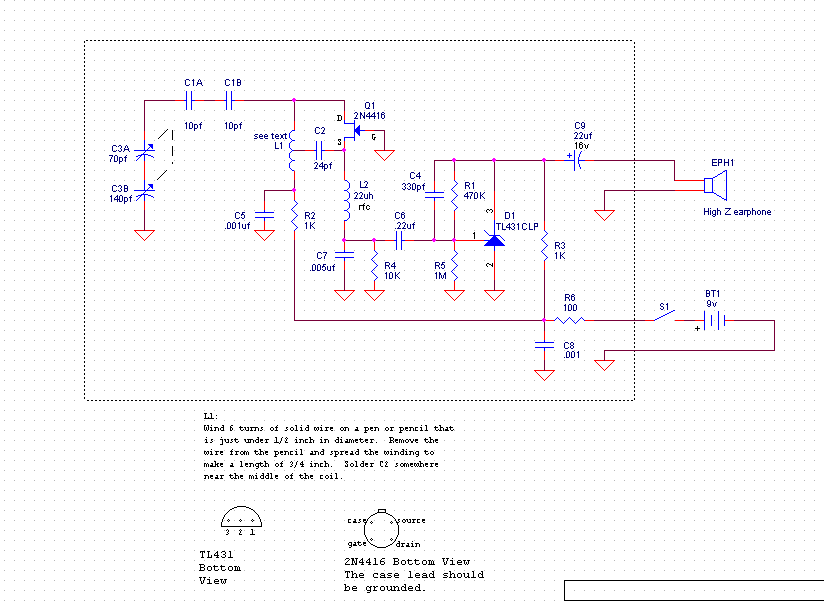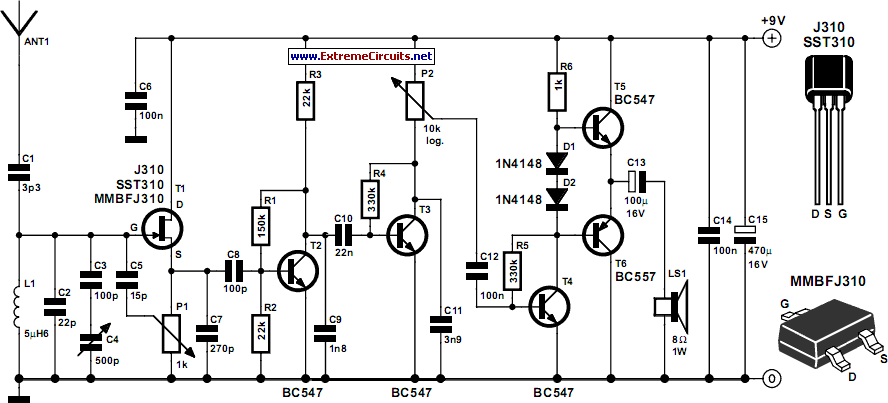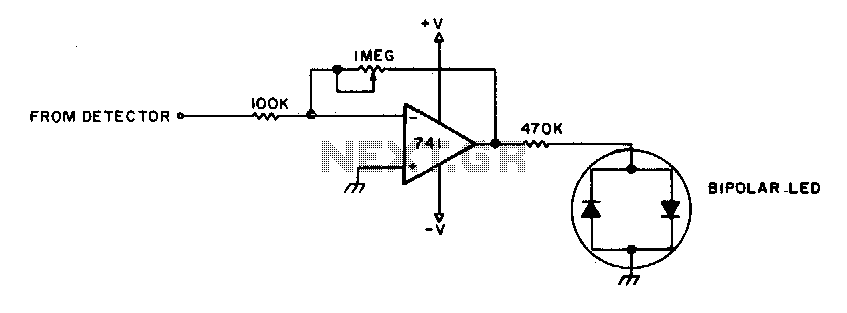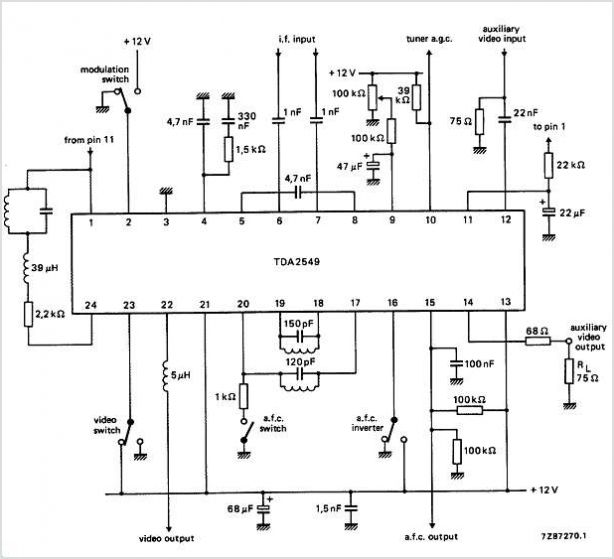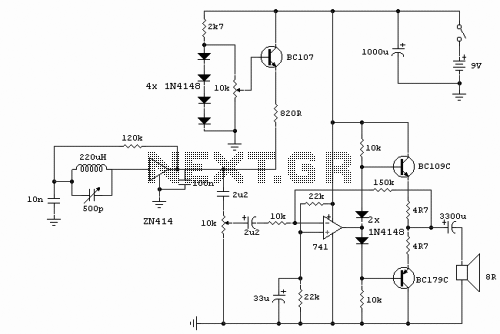
Amazing All-Band Receiver

The Amazing All-Band Receiver is essentially a diode detector followed by a high-gain audio amplifier. This device is not a multi-band receiver; it captures all signals simultaneously. The detector utilizes a biased Schottky diode for superior sensitivity and bandwidth, enabling it to detect signals from below the AM broadcast band up to the microwave bands. The variety of interesting signals received is remarkable; users can enjoy listening to a range of unusual sounds while moving around. By experimenting with different antennas and locations, this receiver can pick up AM radio stations, FM stations, TV video (buzz), car lock transmitters, cell phones, and even sounds from microwave ovens. The method of demodulating FM stations remains unclear, but the antenna's quality may be sufficient for slope detection. Additionally, familiar sounds from narrow-band FM pager transmitters have been detected, along with some enigmatic signals. For instance, unusual descending whistles may be heard near highways, and certain vehicles emit distinctive buzzing sounds. The occasional click may indicate nearby cell phone activity. However, this receiver is not designed for tuning into international shortwave stations; it is optimized for strong, local signals. Advanced experimenters may find it beneficial as a detector section for low-power tuned receivers. Other easily received signals include in-flight aircraft transmissions, CB radio communications, amateur transmitters, surveillance devices, wireless networks, radars, radio control transmitters, certain security systems, and unexpected oscillations in circuits. A short antenna, approximately 6 inches, serves well for general listening, but adjusting its length can enhance sensitivity for specific bands. An RCA or similar connector is recommended for the antenna connection, with the ground linked to the battery negative for loop antennas. Loop antennas, with a loose end grounded, perform particularly well for single frequencies, and a tuning capacitor may be added across the loop. This detector circuit is also effective as a crystal radio, even at higher short-wave frequencies, when a simple tuned circuit is incorporated. A choke of 10 to 100 μH can be placed in series with the antenna to filter out higher frequency signals when receiving AM stations, and the diode should be connected to a high impedance tap on the tuned circuit. The 100 pF capacitor and 10 kΩ resistor are unnecessary if the tuned circuit provides a DC path to ground for the diode. The schematic includes a 100 kΩ volume control, but since signals are typically not loud, this can be substituted with a standard 100 kΩ resistor. The 0.01 μF capacitor should connect directly from the collector of the first transistor to the base of the second. The amplifier is non-inverting; therefore, feedback squeal may occur if earphone wires are too close to the antenna. If feedback is an issue, reducing the 100 pF capacitor in the antenna circuit may help. The circuit consumes only about 125 μA, ensuring excellent battery life. It is designed for sensitive crystal earphones and is not compatible with most other earphone types. However, older sensitive dynamic headphones can be used. To accommodate lower impedance earphones, such as 60 ohm models, the collector and base resistors of the last transistor can be changed from 100 kΩ and 10 MΩ to 1 kΩ and 100 kΩ, respectively, but this will increase battery current. An 8 ohm earphone will necessitate a different output stage for proper performance. A simple plastic enclosure is suitable for housing the device, utilizing pieces of tinned circuit board to support the circuitry.
The Amazing All-Band Receiver circuit is designed to operate efficiently across a wide range of frequencies, making it a versatile tool for both casual users and advanced experimenters. The use of a Schottky diode ensures minimal signal loss and high sensitivity, allowing for the detection of weak signals that might otherwise go unnoticed. The audio amplifier stage boosts the detected signals to a level suitable for listening through earphones, with careful consideration given to the impedance matching to ensure optimal performance.
The antenna design plays a critical role in the receiver's functionality. The recommended 6-inch length serves as a good starting point, but users can experiment with different lengths to fine-tune the reception for specific frequency bands. The use of an RCA connector facilitates easy antenna swaps, and the option to use loop antennas opens up additional possibilities for signal enhancement, particularly for single frequency applications.
The circuit's low power consumption is a significant advantage, allowing for extended use without frequent battery replacements. This is especially important for portable applications where battery life is a concern. The design's simplicity, combined with its ability to detect a wide variety of signals, makes it an ideal project for electronics enthusiasts looking to explore radio frequency phenomena.
In applications where higher sensitivity is required, the addition of a tuned circuit can further improve performance, particularly for short-wave frequencies. The inclusion of a choke in the antenna line helps to filter out unwanted high-frequency signals, ensuring that the receiver remains focused on the desired AM signals.
Overall, the Amazing All-Band Receiver is a remarkable device that showcases the capabilities of simple electronic components to create a versatile and effective radio receiver. Its design allows for significant customization, enabling users to tailor the device to their specific listening needs and preferences.The Amazing All-Band Receiver is basically a diode detector followed by a high-gain audio amplifier. This is not a multi-band receiver; it picks up everything at once! The detector uses a biased Schottky diode for excellent sensitivity and bandwidth; the detector will detect signals from below the AM broadcast band up to the microwave bands. The n umber of interesting signals is surprising; it is fun to drive around listening to the numerous strange sounds. By trying different antennas and locations, this receiver has picked up AM radio stations, FM stations, TV video (buzz), car lock transmitters, cell phones, and even the microwave oven (a whoosh-whoosh sound as the microwave spreader rotated).
It isn`t clear how FM stations are demodulated; perhaps the antenna Q is sufficient for slope detection. (See reader Karen`s excellent theory. ) Even the familiar buzz from a narrow-band FM pager transmitter has been heard - somehow. There are some mysterious signals out there, too! What is that occasional descending whistle over by the highway Some vehicles emit a curious buzz, too.
If you hear a mysterious click-click now and then, its your cell phone! Don`t expect to tune in international shortwave stations. This receiver is for strong, local sources. The advanced experimenter will find it useful as a detector section for low power tuned receivers. Other signals that should be easy to receive include in-flight aircraft transmissions (this passive receiver will not interfere with communication/navigation systems), CB radio transmissions, amateur transmitters, "bugs", wireless networks and devices, radars, radio control transmitters, certain security/alarm systems, and even unexpected oscillations in your next circuit. A short, perhaps 6", antenna is a great general-purpose length for general listening but trimming the length for the a desired band will give better sensitivity.
For the antenna connection, use an RCA or similar connector with the ground connected to the battery negative in case you want to try a loop antenna. Loop antennas (loose end connected back to ground) work especially well for single frequencies and a tuning capacitor may be added across the loop.
This detector circuit will also work well as a crystal radio, even at higher short-wave frequencies with the addition of a simple tuned circuit. Add a 10 to 100uH choke in series with the antenna near the receiver to keep out the higher frequency signals when listening to AM stations and connect the diode to a fairly high impedance tap on the tuned circuit since the diode impedance is high in this circuit.
The 100pF capacitor and 10k resistor are not needed as long as the tuned circuit provides a DC path to ground for the diode. (See Crystal Radio Circuits for tuned circuit ideas. ) The above schematic shows a 100k volume control but the signals usually aren`t loud so this component may be replaced with an ordinary 100k resistor.
The. 01uF capacitor would connect directly from the collector of the first transistor to the base of the second. This amplifier is non-inverting so a feedback squeal will be heard if the earphone wires are too near the antenna.
Reduce the 100pF in the antenna if feedback squeal is a problem. The circuit draws only about 125uA so battery life is excellent. The circuit is designed for a sensitive crystal earphone and cannot drive most other types of earphones. One notable exception is older sensitive dynamic headphones which are rare treasures. To drive a lower impedance earphone, say a 60 ohm type, lower the last transistor`s collector and base resistors from 100k and 10Meg to 1k and 100k but remember that the battery current will be much higher.
An 8 ohm earphone will require a different output stage for satisfactory performance. An inexpensive plastic box makes a great housing. The unit below employs a couple of pieces of tinned circuit board to hold the circuitry and to act as a 🔗 External reference
The Amazing All-Band Receiver circuit is designed to operate efficiently across a wide range of frequencies, making it a versatile tool for both casual users and advanced experimenters. The use of a Schottky diode ensures minimal signal loss and high sensitivity, allowing for the detection of weak signals that might otherwise go unnoticed. The audio amplifier stage boosts the detected signals to a level suitable for listening through earphones, with careful consideration given to the impedance matching to ensure optimal performance.
The antenna design plays a critical role in the receiver's functionality. The recommended 6-inch length serves as a good starting point, but users can experiment with different lengths to fine-tune the reception for specific frequency bands. The use of an RCA connector facilitates easy antenna swaps, and the option to use loop antennas opens up additional possibilities for signal enhancement, particularly for single frequency applications.
The circuit's low power consumption is a significant advantage, allowing for extended use without frequent battery replacements. This is especially important for portable applications where battery life is a concern. The design's simplicity, combined with its ability to detect a wide variety of signals, makes it an ideal project for electronics enthusiasts looking to explore radio frequency phenomena.
In applications where higher sensitivity is required, the addition of a tuned circuit can further improve performance, particularly for short-wave frequencies. The inclusion of a choke in the antenna line helps to filter out unwanted high-frequency signals, ensuring that the receiver remains focused on the desired AM signals.
Overall, the Amazing All-Band Receiver is a remarkable device that showcases the capabilities of simple electronic components to create a versatile and effective radio receiver. Its design allows for significant customization, enabling users to tailor the device to their specific listening needs and preferences.The Amazing All-Band Receiver is basically a diode detector followed by a high-gain audio amplifier. This is not a multi-band receiver; it picks up everything at once! The detector uses a biased Schottky diode for excellent sensitivity and bandwidth; the detector will detect signals from below the AM broadcast band up to the microwave bands. The n umber of interesting signals is surprising; it is fun to drive around listening to the numerous strange sounds. By trying different antennas and locations, this receiver has picked up AM radio stations, FM stations, TV video (buzz), car lock transmitters, cell phones, and even the microwave oven (a whoosh-whoosh sound as the microwave spreader rotated).
It isn`t clear how FM stations are demodulated; perhaps the antenna Q is sufficient for slope detection. (See reader Karen`s excellent theory. ) Even the familiar buzz from a narrow-band FM pager transmitter has been heard - somehow. There are some mysterious signals out there, too! What is that occasional descending whistle over by the highway Some vehicles emit a curious buzz, too.
If you hear a mysterious click-click now and then, its your cell phone! Don`t expect to tune in international shortwave stations. This receiver is for strong, local sources. The advanced experimenter will find it useful as a detector section for low power tuned receivers. Other signals that should be easy to receive include in-flight aircraft transmissions (this passive receiver will not interfere with communication/navigation systems), CB radio transmissions, amateur transmitters, "bugs", wireless networks and devices, radars, radio control transmitters, certain security/alarm systems, and even unexpected oscillations in your next circuit. A short, perhaps 6", antenna is a great general-purpose length for general listening but trimming the length for the a desired band will give better sensitivity.
For the antenna connection, use an RCA or similar connector with the ground connected to the battery negative in case you want to try a loop antenna. Loop antennas (loose end connected back to ground) work especially well for single frequencies and a tuning capacitor may be added across the loop.
This detector circuit will also work well as a crystal radio, even at higher short-wave frequencies with the addition of a simple tuned circuit. Add a 10 to 100uH choke in series with the antenna near the receiver to keep out the higher frequency signals when listening to AM stations and connect the diode to a fairly high impedance tap on the tuned circuit since the diode impedance is high in this circuit.
The 100pF capacitor and 10k resistor are not needed as long as the tuned circuit provides a DC path to ground for the diode. (See Crystal Radio Circuits for tuned circuit ideas. ) The above schematic shows a 100k volume control but the signals usually aren`t loud so this component may be replaced with an ordinary 100k resistor.
The. 01uF capacitor would connect directly from the collector of the first transistor to the base of the second. This amplifier is non-inverting so a feedback squeal will be heard if the earphone wires are too near the antenna.
Reduce the 100pF in the antenna if feedback squeal is a problem. The circuit draws only about 125uA so battery life is excellent. The circuit is designed for a sensitive crystal earphone and cannot drive most other types of earphones. One notable exception is older sensitive dynamic headphones which are rare treasures. To drive a lower impedance earphone, say a 60 ohm type, lower the last transistor`s collector and base resistors from 100k and 10Meg to 1k and 100k but remember that the battery current will be much higher.
An 8 ohm earphone will require a different output stage for satisfactory performance. An inexpensive plastic box makes a great housing. The unit below employs a couple of pieces of tinned circuit board to hold the circuitry and to act as a 🔗 External reference
